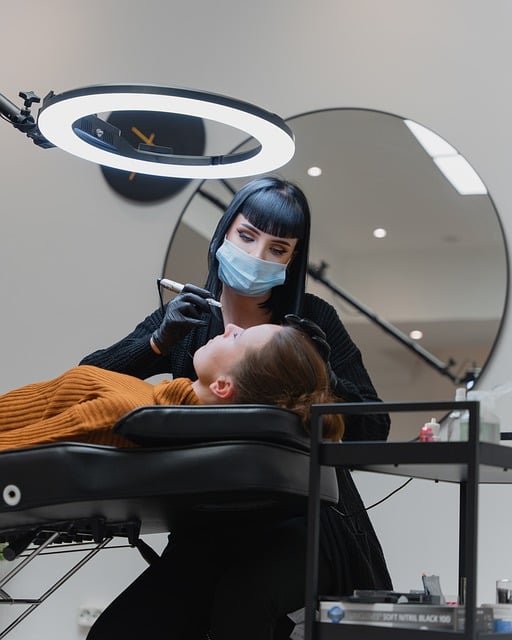Chemical peels, popular aesthetic treatments, offer a non-invasive way to transform skin by exfoliating dead cells and stimulating collagen production. Customizable with various acid formulations (AHAs, BHAs), they address fine lines, hyperpigmentation, acne scars, and more, enhancing texture and tone. The quick, comfortable procedure requires aftercare for optimal results. Choose qualified professionals for safe, effective aesthetic treatments that improve skin health and appearance.
Discover the transformative power of chemical peels, one of the most sought-after aesthetic treatments in today’s skincare landscape. This comprehensive guide delves into the science behind these powerful skin rejuvenation tools, exploring their ability to unlock radiant, healthy complexions. From understanding the various peel formulas to examining their benefits for specific skin concerns, this article equips you with knowledge to make informed decisions about your beauty regimen. Learn about the procedure, aftercare, and safety considerations, ensuring a confident step towards glowing skin.
Understanding Chemical Peels: Unlocking Radiant Skin

Chemical peels are transformative aesthetic treatments that have gained immense popularity for their ability to unlock radiant, rejuvenated skin. These non-invasive procedures involve the application of chemicals to gently exfoliate the upper layers of the dermis, removing dead skin cells and stimulating collagen production. By shedding the outermost layer of skin, chemical peels reveal smoother, more even-toned, and luminous complexions.
This innovative approach to skincare offers a multitude of benefits, addressing various skin concerns. From reducing fine lines and wrinkles to minimizing hyperpigmentation and acne scars, chemical peels provide a tailored solution for those seeking a boost in their skin’s health and appearance. The procedure is carefully customized based on skin type and desired outcomes, ensuring optimal results while maintaining safety and comfort for the client.
The Science Behind Aesthetic Treatments

Chemical peels are a popular aesthetic treatment that offers a non-invasive way to rejuvenate the skin. The science behind this procedure involves using chemicals to gently exfoliate the top layers of the dermis, revealing smoother, more even-toned skin beneath. This process stimulates collagen production, enhances cellular turnover, and improves overall skin texture and appearance.
The specific chemical solutions used in aesthetic treatments vary depending on the desired outcome. Alpha hydroxy acids (AHAs) like glycolic acid are commonly used for mild to moderate exfoliation, addressing fine lines, wrinkles, and hyperpigmentation. Stronger peels may incorporate beta hydroxy acids (BHAs) or trichloroacetic acid (TCA) for deeper penetration and more significant skin transformations. These treatments allow for targeted aesthetic improvements while maintaining the safety and comfort of non-surgical procedures.
Types of Chemical Peel Formulas

Chemical peels are a popular aesthetic treatment used to improve skin texture, tone, and overall appearance. The effectiveness of this procedure lies in its ability to encourage cellular turnover and remove dead skin cells, revealing healthier, smoother skin beneath. Peels come in various formulations, each with unique active ingredients tailored to different skin concerns.
Common types include alpha hydroxy acids (AHAs), beta hydroxy acids (BHAs), and vitamin C. AHAs, such as lactic acid or glycolic acid, are gentle yet powerful exfoliants, ideal for improving fine lines, wrinkles, and hyperpigmentation. BHAs like salicylic acid are particularly effective for acne-prone skin as they penetrate pores to dissolve excess oil and prevent clogging. Vitamin C peels, on the other hand, offer antioxidant benefits, helping to brighten the skin’s complexion and reduce sun damage.
Benefits for Various Skin Concerns

Chemical peels offer a range of benefits for various skin concerns, making them popular aesthetic treatments. For acne-prone skin, these peels can help reduce hyperpigmentation and scarring caused by blemishes, promoting a clearer, more even complexion. By removing the outer layer of skin that contains pigmented spots or scars, chemical peels reveal smoother, brighter skin underneath.
Additionally, chemical peels are effective in addressing fine lines, wrinkles, and age spots. The gentle exfoliation process stimulates collagen production, which improves skin elasticity and texture. This results in a more youthful appearance and a radiant glow. Moreover, they can also help in the treatment of sun damage, melasma, and eczema, providing a comprehensive solution for those seeking improved skin health and a refreshed look.
Procedure, Aftercare, and Recovery

Procedure
A chemical peel is a non-invasive aesthetic treatment that involves applying a chemical solution to the skin to remove the upper layers, stimulating new growth and improving texture and tone. The process usually takes around 20-30 minutes, depending on the type of peel performed. During the procedure, a trained professional will apply the acid blend to your face, ensuring even coverage. You may experience temporary discomfort, but most providers offer numbing creams to mitigate any pain.
Aftercare and Recovery
Following the treatment, your skin will be red and slightly irritated—a common reaction that usually subsides within a day or two. It’s crucial to follow post-procedure instructions carefully, including using gentle cleansers and avoiding direct sun exposure without protection. Your provider may also recommend specific topical treatments to aid in the healing process. This proactive care is essential for optimal results and to minimize any potential side effects. The skin often appears smoother, brighter, and more even-toned after a chemical peel, with improved texture and a rejuvenated aesthetic.
Safety Precautions and Finding a Professional Provider

When considering chemical peels, safety should be your top priority. These aesthetic treatments can have varying levels of intensity, and it’s crucial to choose a qualified professional who adheres to strict safety protocols. Reputable providers will ensure proper sanitation, use high-quality products, and conduct thorough consultations to determine the best course of action for your skin type and concerns. They’ll also provide post-procedure care instructions to minimize potential side effects like redness or peeling.
Finding an experienced provider is key to achieving optimal results and avoiding complications. Look for licensed estheticians or dermatologists with a proven track record in chemical peel procedures. Referrals from trusted sources, online reviews, and certifications from reputable organizations can guide your search. Remember, your skin’s health and appearance are worth investing in, so take the time to research and select a professional who prioritizes safety and delivers effective aesthetic treatments.
